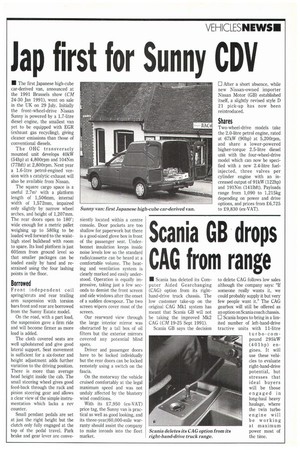Jap first for Sunny CDV
Page 15

If you've noticed an error in this article please click here to report it so we can fix it.
• The first Japanese high-cube car-derived van, announced at the 1991 Brussels show (CM 24-30 Jan 1991), went on sale in the UK on 29 July. Initially the front-wheel-drive Nissan Sunny is powered by a 1.7-litre diesel engine, the smallest van yet to be equipped with EGR (exhaust gas recycling), giving cleaner emissions than those of conventional diesels.
The OHC transversely mounted unit develops 40kW (54hp) at 4,800rpm and 104Nin (771bft) at 2,800rpm. Next year a 1.6-litre petrol-engined version with a catalytic exhaust will also be available from Nissan.
The square cargo space is a useful 2.7m with a platform length of 1,506mm, internal width of 1,572mm, impaired only slightly by narrow wheel arches, and height of 1,207mm. The rear doors open to 180; wide enough for a metric pallet weighing up to 580kg to be loaded well forward to the waisthigh steel bulkhead with room to spare. Its load platform is just 605mm from ground level so that smaller packages can be loaded easily by hand and restrained using the four lashing points in the floor.
Borrowed
Front independent coil spring/struts and rear trailing arm suspension with torsion bars front and rear are borrowed from the Sunny Estate model.
On the road, with a part load, the suspension gave a firm ride and will become firmer as more load is added.
The cloth covered seats are well upholstered and give good lateral support. Seat movement is sufficient for a six-footer and height adjustment adds further variation to the driving position. There is more than average head height inside the cab. The small steering wheel gives good feed-back through the rack and pinion steering gear and allows a clear view of the simple instrumentation which lacks a rev counter.
Small pendant pedals are set at just the right height but the clutch only fully engaged at the top of the pedal travel. Park brake and gear lever are conve niently located within a centre console. Door pockets are too shallow for paperwork but there is a good-sized glove box in front of the passenger seat. Underbonnet insulation keeps inside noise levels low so the standard radio/cassette can be heard at a comfortable volume. The heating and ventilation system is clearly marked and easily understood. Operation is equally impressive, taking just a few seconds to demist the front screen and side windows after the onset of a sudden downpour. The two screen wipers cover most of the screen.
Our rearward view through the large interior mirror was obstructed by a tall box of oil filters but the exterior mirrors covered any potential blind spots.
Driver and passenger doors have to be locked individually but the rear doors can be locked remotely using a switch on the fascia.
On the motorway the vehicle cruised comfortably at the legal maximum speed and was not unduly affected by the blustery wind conditions.
With its £7,950 (ex-VAT) price tag, the Sunny van is practical as well as good looking, and its three-year/60,000-mile warranty should assist the company to make inroads into the fleet market. 0 After a short absence, while new Nissan-owned importer Nissan Motor (GB) established itself, a slightly revised style D 21 pick-up has now been reintroduced.
Shares
Two-wheel-drive models take the 2.0-litre petrol engine, rated at 67kW (90hp) at 5,200rpm, and share a lower-powered higher-torque 2.5-litre diesel unit with the four-wheel-drive model which can now be specified with a new 2.4-litre fuelinjected, three valves per cylinder engine with an increased output of 91kW (122hp) and 191Nm (1411bft). Payloads range from 1,090 to 1,215kg depending on power and drive options, and prices from £6,725 to £9,830 (ex-VAT).












































































